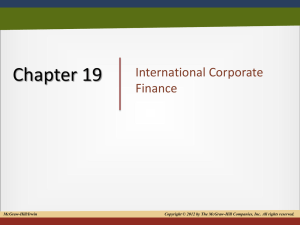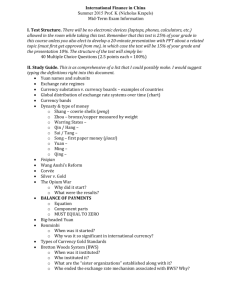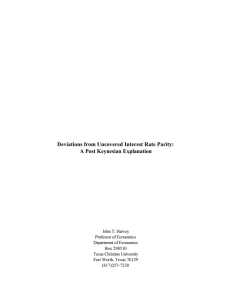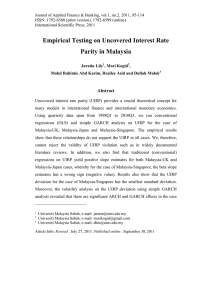Exchange Rates and Business Cycles
advertisement
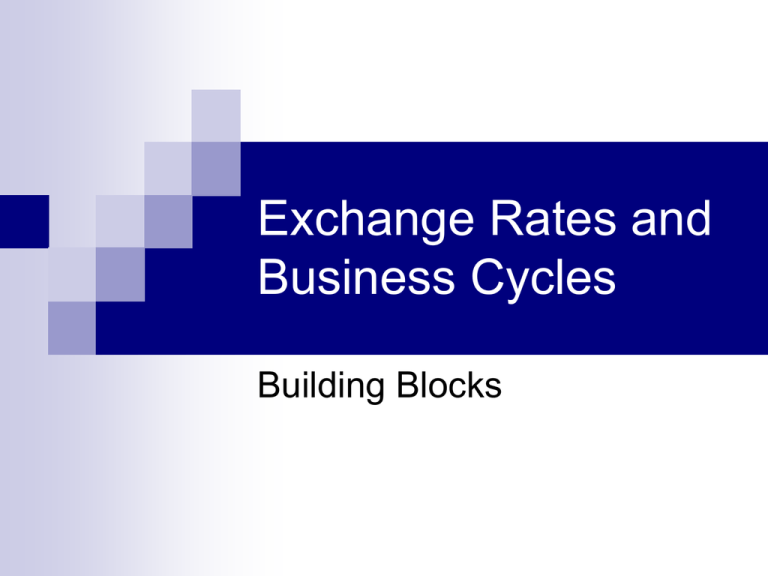
Exchange Rates and
Business Cycles
Building Blocks
Exchange Rates and Long Run
In long-run, relative PPP holds for
countries at similar levels of development.
Long run exchange rate, eLR, given by
long-run real exchange rate, ε, and
money fundamentals.
Long run real exchange rate is given by
level of economic development and
competition in non-traded goods sector.
Exchange Rates in the Short-run
Real exchange rates are volatile in the
short run and closely correlated with
nominal exchange rates.
Under flexible exchange rates, nominal
exchange rates tend to be more volatile
than relative prices.
Smoother Relative Prices than
Exchange Rates in Japan (source IFS)
Exchange Rates vs. Relative Prices
180
160
140
120
100
80
60
40
20
0
2
3
4
1
2
3
4
1
2
3
4
1
2
3
4
Q
Q
Q
Q
Q
Q
Q
Q
Q
Q
Q
Q
Q
Q
Q
86 9 87 9 88 9 90 9 91 9 92 9 93 9 95 9 96 9 97 9 98 0 00 0 01 0 02 0 03
9
1
1
1
1
1
1
1
1
1
1
1
2
2
2
2
P/P
e
19
86
19 Q2
87
19 Q3
88
19 Q4
90
19 Q1
91
19 Q2
92
Q
19 3
93
19 Q4
95
19 Q1
96
19 Q2
97
19 Q3
98
20 Q4
00
20 Q1
01
Q
20 2
02
20 Q3
03
Q
4
Nominal & Real Yen/dollar rates
180
160
140
120
100
e
80
re
60
40
20
0
Building Block 1:
Sticky Prices
Keynesian Explanation
Under the neo-classical dichotomy, goods
markets works like an auction. Firms
produce a fixed number of goods and
demand will determine the price.
Under Keynesian theories, goods markets
work like McDonalds. Firms post a certain
price and produce as many goods as are
demanded at that price.
Keynesian Good Market
Equilibrium
P
AD
P
Y
Sticky Prices and Exchange Rates
Because prices are sticky in the short-run,
changes in nominal exchange rates will
necessarily change the relative prices of
domestic and foreign goods.
Changes in money supply or velocity can
translate into changes in both the nominal
and real exchange rate.
Building Block 2:
Real Exchange Rates and the Current
Account
Trade Balance
At any point in time, there may be a gap in the
value of goods exported and the value of goods
imported.
Measure the trade balance in domestic currency.
Assume imported goods are invoiced in US
dollars
Value
of exports, P∙ EX
Value of imports, e∙ P∙ IM
Value of trade balance or net exports, P∙ EX- e∙ P∙ IM
P EX e PUS IM
e PUS
NX
EX
IM EX re IM
P
P
Effects of Real Exchange Rate on
Real Trade Balance
Direct Effects: Given real imports and
exports, a rise in real exchange rate
makes imports more costly, reducing the
value of the trade balance.
Ex. A country
exports 100 apples and imports
100 oranges. If relative price of apples and
oranges is 100, then trade balance is 0. If
relative price of imports (i.e. oranges) rises,
trade balance will go into deficit.
Expenditure Switching Effect
All else equal, purchasers of goods will
switch their purchases to cheaper goods.
Real
sales of exports will increase when re
rises making domestic goods relatively
cheaper, EX t ( ret )
Real sales of imports will increase when re
rises making domestic goods relatively more
expensive, IM ( ret ).
Both effects imply that an increase in re will
lead to an increase in trade balance.
Net Effect of Real Exchange Rate
on Trade Balance
Two counter-veiling effects of real
exchange rate on real trade balance
Net
effects depend on which effect is stronger
(i.e. does a weaker exchange rate sell more
goods or does it just increase the cost of
goods).
Empirical results:
In
short-run, direct effects are stronger.
In long-run, expenditure switching effects are
stronger.
J Curve Dynamics: Effects of a
once and for all real depreciation
NX
re
time
Exchange Rates and US Current Account
200
160
120
.00
80
-.01
40
-.02
-.03
-.04
80 81 82 83 84 85 86 87 88 89 90 91 92
US Trade Balance
D-MARK/$ Rate
YEN/$
Building Block 2:
International Interest Parity
Spot vs. Forward Markets
1.
2.
Two basic markets for foreign exchange.
Spot Markets – In spot markets, traders
agree on terms/rates for currency trades
with immediate delivery (within 48 hours).
Forward Markets – In forward markets,
traders agree on terms/rates for currency
trades at some specified future date
(usually 30, 90 or 180 days)
Define ft as the exchange rate for delivery
at a date on period in the future.
Forward Markets bigger than spot
(source: BIS)
US$ Millions
Millions Traded per Day in Forex Markets by Maturity
$800,000
$700,000
$600,000
$500,000
$400,000
$300,000
$200,000
$100,000
$0
Spot
Less than 7 7 Days-1 year More than 1
days
year
An investor has $1 for saving.
Consider two investment strategies
Invest $1 in a domestic
bond with interest rate
1+i.
Return: 1+i
Arbitrage in Forex
Market Sets Returns
from 2 strategies to Be
Equal.
Use $1 to buy 1/et
foreign dollars in spot
markets.
Invest 1/et in US$ bonds
at interest rate 1+i$.
Agree on a forward
contract to sell (1+i$)/et
foreign currency for ft+1
domestic dollars.
Return:
f t t 1
et
$
{1
i
t }
ar
Se 96
pM 96
ar
Se 97
pM 97
ar
Se 98
pM 98
ar
Se 99
p9
M 9
ar
Se 00
p0
M 0
ar
Se 01
p0
M 1
ar
Se 02
p0
M 2
ar
Se 03
p0
M 3
ar
Se 04
p04
M
HK$/US$
Spot & Forward Rates
HK Spot & 1 Year Future Rates
8.3
8.2
8.1
8
7.9
7.8
7.7
7.6
7.5
7.4
7.3
e
f
Covered Interest Parity
Sure returns on investing in different
currencies should have
the same price.
t 1
f
{1 it } t
$
{1
i
t }
et
Q: Does covered interest parity hold true?
A:
Yes. Most forex traders use CIP equation to
price forwards.
ft
t 1
{1 it }
$ et
{1 it }
-2
Sep-04
Mar-04
Sep-03
Mar-03
Sep-02
Mar-02
Sep-01
Mar-01
Sep-00
Mar-00
Sep-99
Mar-99
Sep-98
Mar-98
Sep-97
Mar-97
Sep-96
Mar-96
%
US$ and HK$ Government Bills
Interest Differentials
14
12
10
8
i(US$)
6
i(HK$)
4
i(US$)+(f/e)
2
0
Uncovered Interest Parity
Forward prices should equal the market’s
expectation of future spot rate.
If
traders think the future spot price of foreign
currency, et+1 > ftt+1, then why agree to deliver
it at that price. If traders think the spot price of
foreign currency et+1 < ftt+1, why agree to pay
that price.
This should imply a term for exchange rate
parity
1 i
etE1 f t t 1 et
t
1 it$
Implications
We observe that different countries have
different interest rates.
UIRP suggests that countries with high
interest rates are expected to have their
currency depreciate.
The
only reason not to buy bonds in a high
interest economy is that you expect the value
of the currency to drop.
etE1 1 it
$
e
1
i
t
t
Exchange Rate Determination
UIRP Creates a
financial market
theory of exchange
rate determination
Graph expected
returns from investing
in domestic and
foreign currency.
Exchange Rate
equalizes the two
returns.
Invest in
Domestic
Bonds
1+it
Invest in
Foreign
Bonds
e LR
$
(1
i
t )
e
t
Assume expected future
exchange rate is equal to
long run, et+1E = eLR
Equilibrium Exchange Rate
1+i
et
e*
e LR (1 i $ )
t
et
Return
Exchange Rate Determination
Given future exchange
rates, a rise in domestic
interest rates or a fall in
interest rates will lead
to an appreciation.
1.
•
A temporary increase
in domestic interest
rates will lead to
appreciation.
A rise in the future
value of the currency
will increase the current
value.
2.
•
Current exchange rate
depends on whole
path of future interest
rates.
Event
Exchange
Rate
Temporary et ↓
i↑
Temporary et ↑
i$ ↑
eLR ↑
et ↑
Rise in Domestic Interest Rates
1+i
1+i’
St
e*
e**
e LR (1 i $ )
t
e
t
Return
Contradiction and Dynamics
If domestic bond
yields are higher than
foreign yields, we
should expect a
depreciation of
domestic currency
over the life of bond.
A temporary increase
in domestic yields
leads to a domestic
currency appreciation.
Is this a
contradiction?
No, the domestic
currency will
immediately
appreciate and
subsequently
depreciate back to the
original position.
Time Path: Temporary Rise in
Domestic Interest Rates
e
i
time
Rise in Foreign Interest Rates or
Future Depreciation
1+i
et
e***
e*
e LR (1 i $ )
t
e
t
Return
Time Path: Temporary Rise in
Foreign Interest Rates
e
iF
time
Is UIRP true?
UIRP does not hold especially for
developed world countries.
High
interest rate countries do not
systematically see their countries currencies
deteriorate.
Buying bonds in high interest rate
countries generates high average returns.
Why don’t investors take advantage of
these opportunities?
Investors
perceive these countries as having
some risk of an exchange rate depreciation
and investors are risk averse.
Risk Adjusted UIRP
We might assume that there is a risk
premium (either positive or negative) for
investing in domestic bonds relative to
investing in foreign bonds.
et 1
1 it (1 it $ ) 1 rpt
et
A temporary increase in the risk premium
on foreign asset will lead to an
appreciation of the domestic currency.
During Early 1990’s, there were
persistently higher returns earned
in Thai money markets than US.
30
25
20
15
10
5
0
1990
1991
1992
1993
1994
1995
Baht/$ Rate
Thai Money Market Rate
US Money Market Rate
1996
But in July, 1997, owners of Thai
bonds lost 50% of their investment
in US dollar terms.
50
40
30
20
10
0
97Q1
97Q3
98Q1
98Q3
99Q1
99Q3
Baht/$ Rate
Thai Money Market Interest Rate
US Money Market Interest Rate
00Q1
Costs of Exchange Rate
Volatility
Volatile exchange rates generate income
risk for firms that export goods. This may
eliminate some benefits of international
trade.
Volatile exchange rates generate liability
risk for firms that borrow foreign currency
to finance investment projects. This is
especially significant for firms in emerging
markets.
UIRP & Exchange Rate Volatility
1 it 1
1 itF
S
St 2
St
St 1 , t 1
1 it 1
1 it
F
Using UIRP we can write
the exchange rate as a
function of the future
series of exchange rate
differentials.
Since forecasts of future
variables may be volatile
and subject to optimism
and pessimism, this may
explain a large degree of
exchange rate volatility.
St 2
1 itF
St 3 ,...
1 it
1 itF 1 itF1 1 itF 2 1 itF3
St
.....StLR ,
1 it 1 it 1 1 it 2 1 it 3



